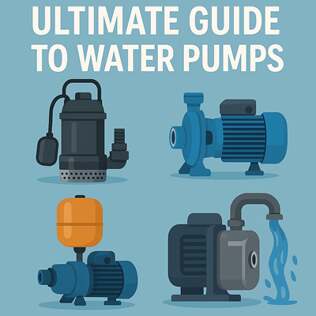Submersible vs. Centrifugal vs. Booster Pumps: Comparison & Buying Guide
Choosing the right water pump can feel like decoding a secret manual, especially when terms like flow, head, and priming keep popping up. This guide cuts through the jargon and shows, plainly and practically, when to pick a submersible, a centrifugal, or a booster pump. You will get quick tradeoffs, installation realities, and buyer tips so the next purchase actually solves your problem.
Quick snapshot: what each pump does
Submersible pump
Sits inside the water (well, sump, or tank) and pushes liquid up. Compact, quiet, and efficient for deep wells and flooded basements. Because the motor runs submerged, cooling is excellent; corrosion and sealing become the main concerns.
Centrifugal pump
A surface pump that uses an impeller to create flow. Needs priming unless it’s self priming. Versatile: irrigation, domestic water supply, and industrial duties. Generally simple to service and available in many sizes.
Booster pump
A category rather than a single design, booster pumps increase pressure in low pressure lines. You’ll find them in apartments, small commercial sites, and garden irrigation systems requiring steady pressure.
Strengths, weaknesses, and best use cases
Submersible
- Strengths: High efficiency, quiet operation, excellent for deep sources.
- Weaknesses: Harder to access for repairs, seals must be reliable.
- Best for: Deep wells, boreholes, sump drainage, applications where noise matters.
Centrifugal
- Strengths: Easy to maintain, broad capacity range, cost effective.
- Weaknesses: Can lose prime, limited suction lift (usually under 8 meters).
- Best for: Surface water transfer, irrigation, remote pumping where serviceability is required.
Booster
- Strengths: Delivers consistent pressure, integrates with tanks and controllers.
- Weaknesses: Adds complexity to plumbing; may cycle frequently without a proper tank or controller.
- Best for: Multi floor buildings, long runs with pressure drop, household water pressure improvement.
How to pick: the practical checklist
- Flow rate and head: Know your required
GPMorL/minand total dynamic head (vertical lift plus friction). Oversizing wastes money. Undersizing causes frustration. - Power source: Electric motors are common; if off grid, check diesel options or solar compatible models.
- Suction situation: If you need suction from a surface source, a centrifugal pump that primes easily or a self priming model matters. For deep lifts, submersible often wins.
- Fluid type: Clean water, dirty water, corrosive liquids; choose materials and seal types accordingly.
- Installation and maintenance: Can you access the pump for repairs? Submersibles need less routine maintenance but are harder to pull out. Surface pumps are easier to service.
- Noise and vibration: For residential installs, submersible or well mounted centrifugal units reduce nuisance.
- Efficiency and running cost: Check pump curves and motor efficiency. A slightly pricier unit with better efficiency pays back over the pump’s life.
- Controls: Pressure switches, variable frequency drives, and pressure tanks reduce short cycling and extend lifespan.
- Warranty and spare parts: Prefer brands with local service and easily obtainable seals, impellers, and motors.
Buying tips that matter
- Match the pump to the duty point, not just the maximum flow on the spec sheet.
- Ask for the pump curve and match it to your system’s head loss calculations.
- For households, consider a small pressure tank and controller with a booster to reduce pump cycling.
- If uncertain, pay a little more for stainless wetted parts when water quality is questionable.
- Keep an extra set of common wear parts: seals and impellers save downtime.
Bottom line: which one should you choose?
If noise and depth are the drivers, choose a submersible pump. If you want ease of access and flexibility for surface water or irrigation, choose a centrifugal pump. If steady pressure for showers, sprinklers, or multi story plumbing is the problem, add a booster with proper controls. Often the best solution uses two elements together: a centrifugal or submersible for supply, plus a booster and tank for pressure stability.
Every installation has quirks; measure your system, know your head and flow requirements, and buy for real duty rather than marketing promises. With the right match, a pump will be a silent, efficient workhorse for years.

